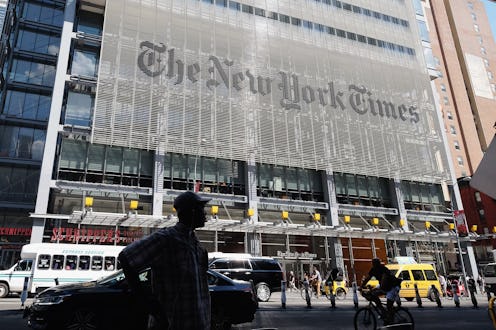News
The NYT's Opinion Piece On Guns Is A Big Deal
The panic caused by tragedies can draw strange reactions from journalists. When a media scrum rushed into the apartment of Syed Rizwan Farook and Tashfeen Malik on Thursday, it showed one of the ugly consequences of the search for answers: A frantic rush for any information that in the process managed to objectify a six-month old orphan and a grieving and likely very conflicted mother. But Saturday, a different media response surfaced when The New York Times published its first front page opinion piece since 1920, calling for greater gun regulation after the San Bernardino attacks. The move was nothing short of historic, and one that reflects an increasing nationwide frustration with gun violence in a bold way.
The lines between opinion and reporting are often blurred. As print subscriptions continue to drop and Americans increasingly incorporate online sources into their primary news digest, there is no longer a visceral wall between editorials and fact-based pieces. That has translated over to exclusively digital media outlets and, increasingly, the online arm of print giants, resulting in columnists, reporters, and a hybrid between the two living on the same feed with little distinction between them.
But the Gray Lady, particularly in her newsprint form, has continued to clearly delineate between its op-eds and reporting. The work of Maureen Dowd, Paul Krugman, and David Brooks is separated from the front page by thousands of inked words and sheaths of paper. Meanwhile, the most valuable real estate is reserved for the day's top headlines. But for the first time in almost a century, The New York Times broke from that practice and published "The Gun Epidemic" on the left column of page one with the label "Editorial" and a thin border serving as its only distinction from hard news items.
The importance of making such a bold statement wasn't lost on the paper's publisher, Arthur Sulzberger, Jr. "Even in this digital age, the front page remains an incredibly strong and powerful way to surface issues that demand attention,” Sulzberger said in a statement. “And, what issue is more important than our nation’s failure to protect its citizens?"
Certainly, publishing that piece in such a prominent way rather than burying it within its own pages was powerful, but it's also a potentially alienating move for The Times. A Gallup poll published in September showed that only 40 percent of people have a "great deal" or "good amount" of trust that news outlets are delivering accurate reporting, which puts trust in the media at an all-time low. And according to research published in Political Communication, trust in media has been on the decline over the last thirty years. That's due in part to declining readership among the press' core support, which was built on Democrats and liberals, so it's fair to say the current readership — one that already senses bias — is largely conservative.
As a bastion of American journalism, the paper would never put itself in the middle of a fierce debate barring extraordinary circumstances. A public that doesn't trust its news sources prohibits the news from fulfilling one of the tenets of journalism: Serving as a watchdog for the public. And for all of its charges as a "liberal rag," The Times is likely wholly uninterested in saying things just to stir the pot. There are plenty of other outlets for that kind of rhetoric. Beyond that, the paper may be a giant in the industry, but it still feels the sting of a financial climate that is tepid at best, and anything that could lead to a dip in subscriber dollars is generally frowned upon.
So think, then, how massive of a decision it was to publish the first opinion piece on the front page in 95 years on such a controversial topic. No, opinion columns will never be met with everyone's support — that's why they're opinions. But it took something like gun control for The New York Times to finally get worked up enough to advocate in such a big way. That, more than the charged up talking points on MSNBC, Fox News, or CNN, is more telling of just how desperate we are as a nation to find a solution to mass shootings.
And it wasn't a half-bad read, either.
Image: The New York Times (1)
